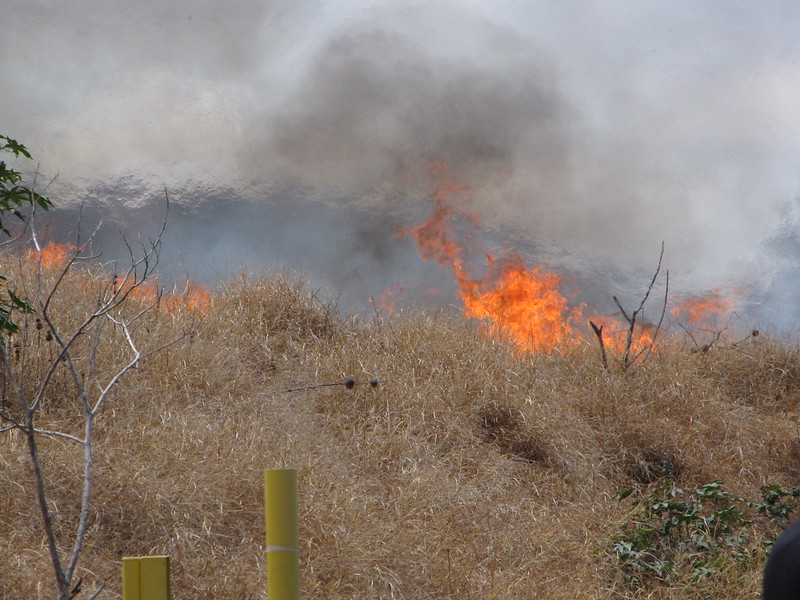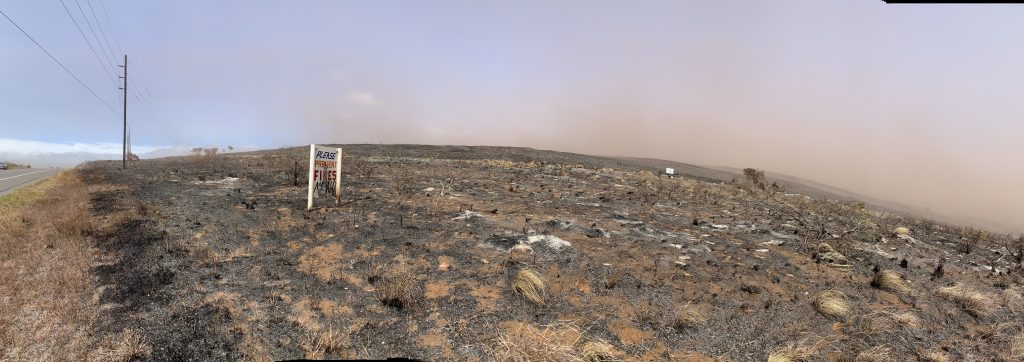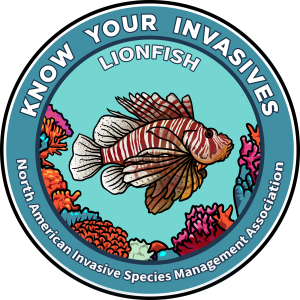In 2021, the Mana Road fire on Hawaiʻi Island burned 42,000 acres and is currently considered the largest wildfire crisis in Hawai’i. The fire was fueled by non-native grasslands. This photo was taken after the fire alongside Highway 190. Photo credit: Elliott Parsons
By: Dr. Elliott Parsons – Pacific RISCC & Christy Martin – CGAPS
Weeks have passed since the deadly fire in Lahaina, one of several wildfires that started on Maui and on Hawaiʻi, the “Big Island,” on August 8-9, 2023. Many of us learned about the fire triangle, that without one of the three components – oxygen, heat, and fuel – a fire cannot start or be sustained. High winds with gusts up to 80 miles per hour were recorded on the dry, leeward slopes of the islands from Hurricane Dorapassing 550 miles to the south and exacerbated by a strong high-pressure system north of the islands, which led to low humidity. As officials and communities look for answers about the ignition sources, it is worth understanding how the islands came to have an overabundance of fuel and the challenges ahead with the synergistic effects of invasive species and climate change.
A history of land use changes and grass invasions
Like many tropical Pacific islands, Hawaiʻi has far fewer lightning strikes than continental systems, and thus ecosystems and species did not evolve with fire as a regular part of the system. Polynesian voyagers first arrived in Hawaiʻi more than 1,000 years ago, bringing a handful of culturally important non-native plants and animals, and are believed to have used fire to clear some lowland areas for agriculture and to promote useful plants. The changes that came after Western contact 245 years ago included the introduction of livestock (including cattle, goats, and sheep), drought-resistant grasses and shrubs for their fodder, and foreign ideas such as private land ownership.
In the upland watershed forests, introduced trees became invasive and began spreading and displacing native trees. Strawberry guava, which was introduced in 1825 as an ornamental with edible fruit, is now the most abundant tree in Hawaiʻi, present across more than 443,000 acres in 2019. This invasive tree was shown to transpire 53% more water into the atmosphere in dry years than the native ʻōhiʻa trees they replaced, water which used to seep into aquifers, cool the forest, raise humidity, and feed streams. The last one hundred years also saw the average annual rainfall decrease across 90% of the islands with the greatest declines in already dry leeward areas.
In the lowlands, large tracts of land were owned and operated as sugar or pineapple plantations supported by water that was diverted from streams, and grazing lands covered more than 2 million acres across the Hawaiian Islands. By the 1990s most plantations had closed, and the drought-resistant grasses and shrubs quickly filled the fallow fields. As well, pasturage declined due to the shifting economics of cattle grazing, leaving large areas of uneaten invasive and fire-promoting grasses to proliferate. Dry forest ecosystems were also invaded by introduced forage grasses like guinea grass and buffelgrass, and by ornamental species such as the fire-adapted fountain grass. Recent estimates suggest that about a quarter of the land area in Hawaiʻi (about a million acres), is now covered in flammable invasive grasses and shrubs, and a sobering assessment by the Western Council of State Foresters found that a greater percentage of Hawaiʻi’s land area is under higher risk of wildfire than the 16 western-most states in the U.S.
The threat of wildfire in Hawaiʻi

By compiling and analyzing statewide records, scientists found in 2015 that the average area burned in Hawaiʻi had increased by 400% over the last century. This increase in the size of fires, while driven largely by a decline in vegetation management and livestock grazing on former agricultural lands and the proliferation of non-native grasses and shrubs, has also paralleled a significant increase in the duration and severity of drought in Hawaiʻi. The two worst droughts over the last 100 years both occurred since the late 1990s. Drought can elevate fire risk by lowering moisture levels in the soil and plants, which increases flammability, and both wildfire and drought can magnify future fire risk when invasive grasses cover areas formerly burned or denuded by drought. The consequences of these long-term changes in Hawaiʻi have been severe. A USGS report in 2018 found that the density of invasive species is almost 200% higher in Hawaiʻi as compared to the U.S. continent. And, due to the warm, tropical climates in Hawaiʻi, these invasive plants have favorable growing conditions year-round. Invasive grasses in particular can respond rapidly to rainfall, greatly increasing in size and height during wet years. This has led to a “fire season” that lasts 12 months, compared to only a 7-month average fire season in the continental U.S. While fire risk can vary depending on time and location, many low-elevation and dry leeward areas face very high to extreme fire risk all year long.
Wildfires now burn a higher percentage of land annually in Hawaiʻi (0.48%) than in the continental U.S. (0.3%). And despite the small land area, the islands are home to 1.4 million people and receive more than 9 million visitors annually, many to communities in or adjacent to large areas of invasive and flammable grasses. These areas, where developments intermix with wildland fuels, are called the wildland-urban interface and are indicative of a high risk of wildfire. Based on an analysis in 2020, 94.4% of the homes in Hawaiʻi were found to be vulnerable because they are built within the wildland-urban interface compared with 42.3% of structures in the conterminous U.S.
Invasive grasses and wildfire

While land use and climate affect the risk of wildfire crisis in Hawai’i, it is important to understand how invasive grasses themselves also contribute. Invasive grasses exacerbate wildfires because grasses have thin tissues that can dry quickly and burn easily. Invasive grasses also support a significant proportion of dead-standing plant material that is very slow to decompose, and they can provide continuous fuels across large areas that allow fire to spread long distances before they are stopped. These fine fuels can also burn under a broader range of conditions than can other fuel types (e.g., wood or leaf litter). As a result, grasses support a microenvironment that is hotter and drier than in forests or shrublands. This means that the conditions that favor fire are much more common in grass-invaded areas. Hawaiʻi is not alone in this increasing trend of invasive grassland-fueled fires. A 2019 study found that six species of fire-prone invasive grasses in the continental U.S. were linked to a 150% increase in fire frequency. Buffelgrass, one of these six species, was one of the forage grasses introduced to Hawaiʻi. It has one of the highest fire-risk ratings of all invasive plants in Hawaiʻi, and it can even burn when green. It was found to be prolific around Lahaina before the wildfire and is found extensively throughout Hawaiʻi. Invasive grasses in Hawaiʻi have also fueled some of the largest wildfires. For example, the Mana Road fire on Hawaiʻi Island in 2021 was the largest wildfire crisis in Hawai’i and burned ~42,000 acres. This fire led to the evacuation of the nearby town of Waikoloa and created dust storms that lasted for months, making driving conditions hazardous and reducing air quality for thousands of nearby residents. While fires do burn in shrublands and forests, more than 80% of the area burned annually in Hawaiʻi is in non-native grasslands.
Invasive species and climate change
The devastating fires in Lahaina and Kula, Maui in August are clear examples of the synergistic effects of invasive species and a changing climate. Recent declines in rainfall coupled with increasing drought severity have already created parched conditions in leeward areas, yet climate change is likely to exacerbate dry conditions. Higher temperatures, as well as larger, more severe storms and drought, are all projected to increase with climate change, and these impacts will most certainly interact with invasive grasses and shrubs to affect wildfire risk.

So, what can be done? There is no single fix or silver bullet to protect communities and native species from invasive plant-fueled wildfires in Hawaiʻi. Instead, there are multiple tools that will need to be used and each will help. These include a focus on more holistic land-use planning to incentivize risk reduction and enhance ecosystem services and public well-being. Identifying support mechanisms that empower ranchers and local agricultural producers could reduce existing fuel loads while also meeting food security goals. Also, land that is set aside to provide fire buffers around communities could be planted with low-fire risk crops including indigenous Hawaiian agroecosystems, non-invasive plants with low flammability, or endemic dryland forest trees and shrubs that lower fire risk.
Finally, identifying and restricting the introduction of new species of flammable non-native species should be a priority. For those particularly harmful species already present, biocontrol is the only viable way to reduce the abundance and vigor of widely established invasive plants, followed by active restoration of plants that can better serve communities and ecosystems. And while climate change impacts are projected to favor prime wildfire conditions and ignitions will continue to be difficult to control at best, we need to roll up our sleeves and work together to effectively manage fuels to break the fire triangle and protect communities.
For a version with references click here





